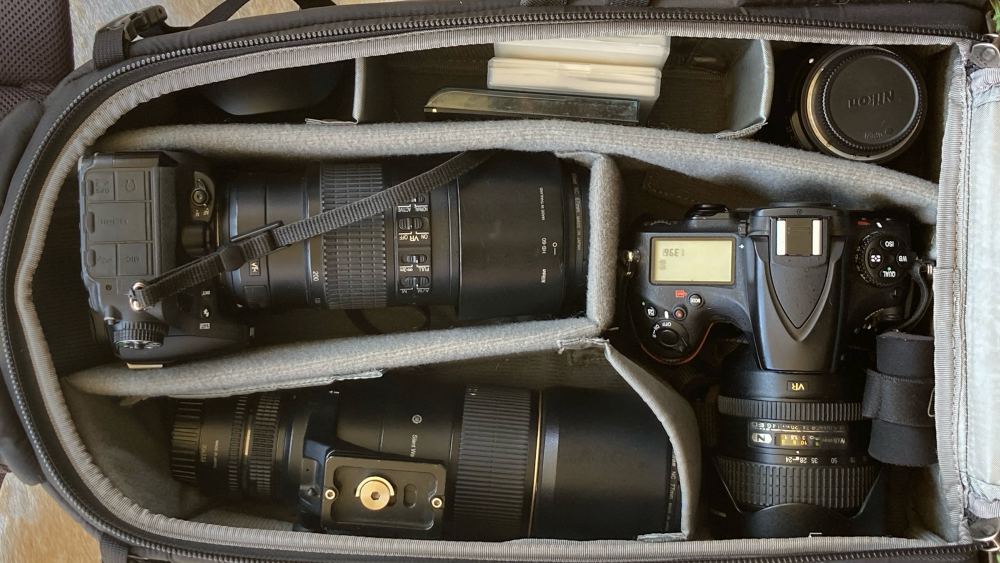My core equipment
There is a well-known saying that the best camera is the one you have with you. This is only too true. Several years ago my wife and I were sitting quietly by a waterhole in the St Lucia wetlands in South Africa, when we saw two zebra approaching for their afternoon drink. My wife gestured to me that a third zebra was about to arrive but as they were on the far side of the waterhole I knew I would need a longer lens. While I was changing the lens at the car the third zebra joined his friends in this perfectly reflected pose. My wife took this with her small ‘point and shoot’ camera. The horizon wasn’t level and the zebra weren’t in the centre but those faults were easy to fix. She got the picture while I was fiddling elsewhere!
Being in Africa is awe-inspiring, but the photographs often don’t live up to the memory of what you saw, particularly when photographing wildlife in the landscape. When you look at a view, your eye zooms in and out to create a composite impression and memory within the brain. This image is a heightened version of reality, focused on the objects that matter, in this case the wild animals. To capture this with a camera, you need both careful composition and a shallow depth of field, making the subject stand out from the background. This is why keen photographers use large sensor cameras with interchangeable wide aperture lenses, despite the size and weight penalties. In contrast, a ‘point and shoot’ camera or a mobile phone can’t create a shallow depth of field, so images often end up a bit ‘flat’. But this is much better than having no camera at all, as my zebra story illustrates.
My son-in-law runs Macatoo camp in the Okavango Delta in Botswana. The camps in the Delta are private concessions so, apart from the camp guests, there are no other tourists or vehicles there. This is photography heaven, with endless vistas unspoilt by other safari vehicles and is regularly visited by professionals. My son-in-law is a serious photographer himself, and has Nikon’s 70-200 f2.8 and 300mm f2.8 lenses which I can use when I am there. There is no doubt that these 2.8 lenses give sharper images and more ‘keepers’ than the f4 lenses, as in the close up of a leopard below taken with the 300mm f2.8 at f2.8 on the D7100.
However, these f2.8 telephoto lenses are not only very expensive but also big and heavy, as are all of the Nikon top end telephotos. The tight hand luggage weight and size restrictions on regional flights within Africa, and even tighter restrictions on the small planes that fly into the camps, mean that it isn’t practical to take these lenses with you as hand luggage. My compromise is to use f4 lenses, which are typically half the weight and size, accepting a slight drop in performance for a big gain in portability. I should make it clear from the start that all the equipment I own, I have bought and paid for myself; there are no hidden promotions on this blog.
To reduce the number of times I am caught with the wrong lens, I now take two camera bodies with me. The first is a full frame Nikon D810, on which I keep a 24-120mm f4 zoom, good for landscapes, animals close by, and large animals, such as elephant. My second camera is a crop sensor Nikon D7100, on which I keep a 70-200 f4 zoom, giving an equivalent 105 to 300mm focal range. This is good for animals in the distance and birds nearby. These two camera and lens combinations give an instant range of 24mm to 300mm, which is enough for most normal situations and better than scrabbling around in a bag and failing to get the right lens in time.
I also take other lenses with me. At the wide end, a 20mm f1.8 lens is good for some landscapes and is also useful for nightscapes. It is small and light enough to sit in the bag until needed.
At the long end, I have a 300mm f4 and a 1.4x teleconverter giving me an equivalent of 450mm and 630mm on the D7100. At these extreme telephoto lengths even the smallest wobble will lead to blurry images, so a tripod or other stabilisation is needed to get sharp images. This extra reach is particularly useful for bird photography, like this Red Bishop clinging to the reeds at Karoo Ridge. The other problem with very high focal lengths is heat haze distortion, which becomes an issue in the afternoon and evening; this picture was taken at seven in the morning.
This, then, is my every day safari pack, covering an equivalent focal length range of 20mm to 630mm, with an instantly available range of 24mm to 300mm, mostly at f4, and all in one bag that can be carried as hand luggage. Yes, it is a compromise, but over time I have found that this is the compromise that works best for me.





